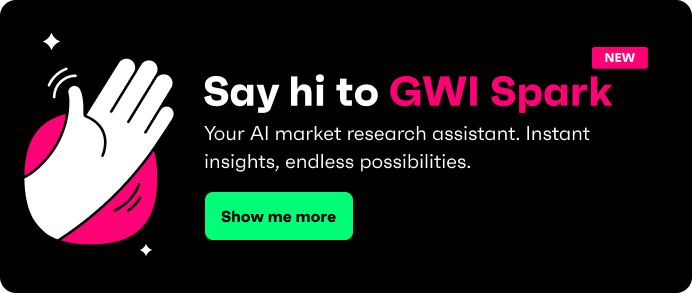
Today’s shopper isn’t just multitasking, they’re practically living in split-screen mode. One minute they’re watching the latest Apple+ crime drama, the next they’re scrolling Instagram reels, and somewhere in between they’re googling toaster reviews (four slices is where it’s at, right?). For marketers, that means the old “buy one big ad spot and hope for the best” strategy doesn’t cut it anymore. You need a clear channel plan that maps out where your audience really is and what gets them to take action. In this guide, we’ll break down what channel planning actually looks like, why it’s more important than ever, and how GWI and Spark can help you swap gut instinct for real insights.
What is channel planning?
Channel planning is essentially your brand’s GPS, helping you meet your audience, across paid, owned, and earned touchpoints. It’s the roadmap that links a stranger’s first encounter with your brand to the moment they hit “buy”. Back in the day, a knock-out TV ad might’ve done the trick. Today? That same person might scroll TikTok, watch streaming TV, play a game, and check out your product in-store, all before buying. A smart channel plan helps you connect those dots.
Why channel planning matters now
Let’s be honest, keeping up with media habits is like chasing a moving target. Most internet users flip between two screens at once, half-watching on one and Whatsapping on another, or catching up with a podcast while online shopping. Daily time spent with online video rivals traditional TV, while audio streaming and social commerce carve out their own prime slots in the day. Add rising expectations for personalization and relevance, and the stakes climb higher. Brands that don’t show up in the right place risk fading into the background noise. Sound familiar?
Four core steps to effective channel planning
Every successful plan follows the same four-step rhythm. With fresh consumer insights plugged in at each stage, the process moves from theory to action fast.
Step 1: define and segment your audience
Start by bringing your customers to life. Beyond age and location, dig into their attitudes, aspirations, and day-to-day behaviours. GWI Core lets you layer that detail in seconds. GWI Spark then surfaces instant differences between segments. That’s handy when you need to understand why eco-minded millennials binge podcasts yet still trust review sites for purchase decisions.
Step 2: map key consumer touchpoints
Plot the moments when a prospect discovers, researches, and finally buys. For some audiences, brand discovery still leans on search and TV. Others stumble across products through creators on short-form video. Use GWI’s journey data to see which touchpoints actually move the needle, then validate them with the real-time answers Spark generates.
Step 3: select and prioritise channels
Rank each channel for reach, fit, cost, and conversion potential. Overlay GWI’s media-habit data with first-party analytics to find the sweet spots. Maybe Instagram Reels drives curiosity. Your email series nurtures consideration. Retail media closes the sale. Use these inputs to build a media channel plan you can defend in any budget meeting. The aim isn’t to be everywhere - but to be in the places that matter most to your specific audience.
Step 4: develop tailored content for each channel
Content should feel native to its environment and relevant to your viewer’s mindset. A 30-second tutorial Reel scratches an itch on social. A long-form blog post satisfies deeper research needs. Spark can suggest hook lines and pull supporting stats in seconds, so your creative team spends less time chasing proofs and more time doing the work that makes real change happen.
Measuring and optimizing your channel plan
Don’t wait until the end to figure out if your plan worked. Set clear metrics from the start, whether that’s return on ad spend, engagement rates, or something else that actually moves the needle for your business. Keep an eye on how things are going early. GWI gives you a benchmark, and Spark helps you spot trends as they happen. If mobile use spikes on weekends? Shift your spend. Small tweaks early on can save big chunks of budget later.
Example in action: Nextdoor’s insight-led channel plan
Neighborhood platform Nextdoor needed to prove its ad solutions reached purchase-ready locals. By building an Insights Hub powered by GWI Core and layering in first-party stats, the team could pinpoint exactly when and where neighbors were most active. Page views shot up nearly 200% in a year, and they even landed a spot on the ANA Genius Awards shortlist. Bottom line? When you let data lead the way, great things happen.
Common channel planning pitfalls and how to avoid them
Even the most experienced marketers hit snags (sorry - it’s true). Maybe it’s clinging to outdated assumptions, stretching the budget across too many channels, or treating each platform like its own little island. But, the fix can be simple. Ground every decision in current data, concentrate spend on high-impact touchpoints, and test cross-channel combos rather than single placements. Pairing connected-TV ads with social retargeting, for example, often reveals multipliers you’d miss by looking at each channel solo.
How GWI and GWI Spark supercharge channel planning
GWI’s global survey data shows you the who and the why. Spark helps you figure out what to do next. Want to know how pet-loving Gen Zers in Canada spend their weekends online? Just ask. Spark will pull up the data in seconds with no digging required. From there, it’s easy to plug insights into your plan, spin up a deck for stakeholders, and make informed decisions while others are still fiddling with last year’s PowerPoint.
Future trends shaping channel planning
Retail media is exploding. Shoppable video is making content and commerce one and the same. And, as privacy rules tighten, personalization has to evolve. Each trend requires an always-on stream of consumer insight because the channels that work today may not tomorrow. Stay curious, and stay informed.
FAQs
What is a media channel plan?
It’s a documented overview of the platforms, placements, and budget splits you’ll use to reach a target audience across the funnel.
How do I create a cross channel strategy?
Start with fresh audience data, map key touchpoints, rank channels by impact, then tailor creative for each environment. Iterate every quarter.
Which tools help with channel planning?
GWI Core offers global consumer data, Spark delivers instant segment insights, and your analytics suite confirms performance in the market.
How often should I revisit my channel plan?
Quarterly reviews catch shifts in behavior early, but always refresh before major campaigns or budget cycles.
Summary: building a channel plan that delivers
Channel planning isn’t about throwing stuff at a wall and hoping some will stick. It’s about understanding your audience, knowing where they spend their time, choosing the right mix of channels, creating content that feels right in each one, all the while keeping a close eye on what’s working. With GWI’s data depth and Spark’s speed, every phase becomes sharper and faster, letting you meet real consumer needs and maximize ROI.





.webp?width=495&height=317&name=pink_thumb_graphs%20(1).webp)
.webp?width=495&height=317&name=pink_thumb_letter%20(2).webp)